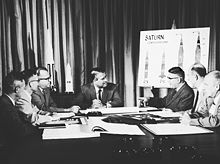- Dieter Grau
-
Dieter Grau 
Born April 24, 1913
GermanyNationality  German,
German,  United States of America
United States of AmericaFields Aeronautics Institutions Peenemünde
Fort Bliss
Redstone Arsenal
Marshall Space Flight CenterDieter Grau (April 24, 1913)[1] is a retired rocket scientist and member of the "von Braun rocket group", at Peenemünde (1939–1945) working on the V-2 rockets in World War II. He was among the scientists to surrender and travel to the United States to provide rocketry expertise via Operation Paperclip which took them first to Fort Bliss, Texas (1945–1949). He continued his work with the team when they moved to Redstone Arsenal, and he joined Marshall Space Flight Center to work for NASA. Grau served as the director of quality in all of those positions, including for the Saturn V rocket which took man to the moon.[2]
One of those engineers was Dieter Grau, now 97, who worked in quality control at White Sands. He arrived in 1946 and his wife in 1947. His son was born in Texas in 1949 before the family moved to Huntsville in 1950.[2]
"We were brought over by the Army," Grau said, adding that von Braun worked closely with then Col. Holger Toftoy to develop the kind of team he wanted in the U.S.[2]
While von Braun and his team waited at Fort Bliss, Grau and other German engineers stayed relatively busy at White Sands, where they assembled V-2 rockets from parts shipped with them from Germany, and then launched them in demonstrations for U.S. scientists. A total of 67 V-2s were launched at White Sands.[2]
"One of my main jobs at that time was to get information to the scientists and see what kind of projects they would like to have and then, of course, we had to accommodate them," Grau recalled. "Even though we were busy, we were more used to much overtime. But that was not the case (at White Sands). There we had a normal workday."[2]
 Von Braun's rocket team managers, Grau just right of center, meet to discuss Saturn configurations in 1961.
Von Braun's rocket team managers, Grau just right of center, meet to discuss Saturn configurations in 1961.
Things changed with their arrival in Huntsville. In many ways the Germans felt like they were coming home. Gone were the dry, desert conditions of Fort Bliss and White Sands, replaced with a green, mountainous agricultural area reminiscent of Germany.[2]
"Coming to Huntsville was our coming back to the green country," Grau said. "We were used to green country and out there at Fort Bliss and White Sands there was just desert. We liked this so much better. This was more the landscape we were used to. For us, it was kind of a relief to come to the green country."[2]
"The new [Redstone] rocket had to go somewhat further. It had to be bigger and it had to be made with American parts," Grau said. "Industry came in and worked with us to build and develop new stuff. The engine had to be redesigned. It had to be bigger. At that time, industry came really onboard."[2]
Grau, along with von Braun's team, moved from the Army to NASA to develop the first rockets designed expressly for exploration.
"We had wonderful experiences going into space. We had wonderful cooperation to accomplish something never done before," Grau said. "See how well it all worked out? We had no idea how things would work out. We took a tremendous risk to come here. We never thought we would be able to stay so long. I have real good fortune that I have had a fulfilled life and I remember so much."[2]
References
- ^ "Grau". Astronautix. 2004. http://www.astronautix.com/astros/grau.htm. Retrieved December 17, 2010.
- ^ a b c d e f g h i Kari Hawkins, USAG Redstone (2010-07-02). "German Reunion Highlights Two Anniversaries". US Army. http://www.army.mil/-news/2010/07/02/41792-german-reunion-highlights-two-anniversaries/. Retrieved December 18, 2010.
Categories:- German aerospace engineers
- American people of German descent
- Rocket scientists
- 1913 births
- Living people
- Early spaceflight scientists
- German emigrants to the United States
- German inventors
- German people of World War II
- German scientists
Wikimedia Foundation. 2010.
